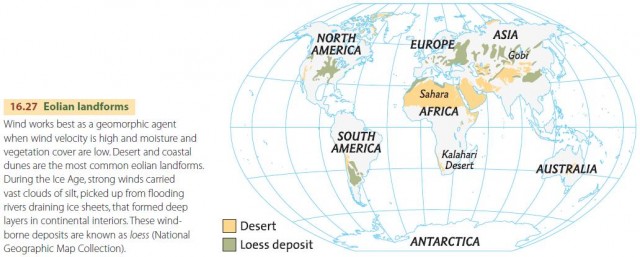Wind Action
Wind plays a direct role in shaping coastal landforms, carrying sand and other sediments, and depositing them at new locations. We use the term eolian, which comes from “Aeolus,” the name of the Greek god of the winds, to describe wind-generated landforms and processes. Dunes are thus eolian landforms. Figure 16.27 is a global map showing regions where eolian processes and landforms are found.
Ordinarily, wind isn't strong enough to dislodge mineral matter from the surfaces of unweathered rock, from moist, clay-rich soils, or from soils bound by a dense plant cover. Normal winds only erode and transport sediment on land surfaces where small mineral and organic particles are in a loose, dry state—typically, deserts and semiarid lands (steppes). In coastal environments, beaches can also provide a supply of loose sand to be shaped. Here the wind builds coastal dunes, even where the climate is humid and the land surface inland from the coast is well protected by a plant cover.

EROSION BY WIND
Wind performs two kinds of erosional work: abrasion and deflation. Loose particles lying on the ground surface may be lifted into the air or rolled along the ground by wind action. In the process of wind abrasion, wind drives mineral particles against an exposed rock or soil surface, wearing down the surface.
The sandblasting action of wind abrasion is usually limited to the bottom meter or two of exposed rock above a flat plain. That's because sand grains don't rise much higher into the air. Wind abrasion produces pits, grooves, and hollows in the rock. You'll often see that wooden utility poles on windswept plains have a protective metal sheathing or a heap of large stones placed around the base. Without this protection, they would quickly be cut through at the base.
Deflation is the removal of loose particles from the ground by wind. Deflation acts on loose soil or sediment, and so dry river courses, beaches, and areas of recently formed glacial deposits are susceptible. In dry climates, much of the ground surface can be deflated because the soil or rock is largely bare of vegetation.
The finest particles, those of clay and silt sizes, are lifted and raised into the air—sometimes to a height of a thousand meters (about 3300 ft) or more. Sand grains are moved by moderately strong winds and usually travel within a meter or two (about 3 to 6 ft) of the ground. Gravel fragments and rounded pebbles can be rolled or pushed over flat ground by strong winds, but they don't travel far. They become easily lodged in hollows or between other large particles. If there's a mixture of particles of different sizes on the ground, deflation removes the finer sized particles and leaves the coarser particles behind.
A blowout is a shallow depression produced by deflation. The size of the depression may range from a few meters (10 to 20 ft) to a kilometer (0.6 mi) or more in diameter, although it is usually only a few meters deep. Blowouts form in plains regions of dry climate. Any small depression in the surface of the plain, especially where the grass cover has been broken or disturbed, can form a blowout. Rains fill the depression and create a shallow pond or lake. As the water evaporates, the mud bottom dries out and cracks, leaving small scales or pellets of dried mud. These particles are lifted out by the wind.
Deflation is also active in semidesert and desert regions. In Chapter 15, we saw that the centers of desert basins often hold saline playa deposits. In the southwestern United States, playas often occupy large areas. Deflation has reduced many of these playas by several meters. Rain beating down on the ground, overland flow, and deflation may be active for a long period on the gently sloping surface of a desert alluvial fan or alluvial terrace.
These processes remove fine particles, leaving coarser, heavier materials behind. As a result, rock fragments ranging in size from pebbles to small boulders become concentrated into a surface layer known as a desert pavement. The large fragments become closely fitted together, concealing the smaller particles—grains of sand, silt, and clay—that remain beneath. The pavement acts as an armor that protects the finer particles from rapid removal by deflation. However, the pavement is easily disturbed by wheeled or tracked vehicles, exposing the finer particles and allowing severe deflation and water erosion to follow.
DUST STORMS
Strong, turbulent winds blowing over barren surfaces can lift great quantities of fine dust into the air, forming a dense, high cloud called a dust storm. In semiarid grasslands, dust storms are generated where ground surfaces have been stripped of protective vegetation cover by cultivation or grazing. Strong winds cause soil particles and coarse sand grains to hop along the ground.
This motion breaks down the soil particles and disturbs more soil. With each impact, fine dust is released that can be carried upward by turbulent winds. A dust storm approaches as a dark cloud extending from the ground surface to heights of several thousand meters. Typically, the advancing cloud wall represents a rapidly moving cold front. Standing within the dust cloud, you are shrouded in deep gloom or even total darkness. Visibility is cut to a few meters, and a fine choking dust penetrates everywhere.